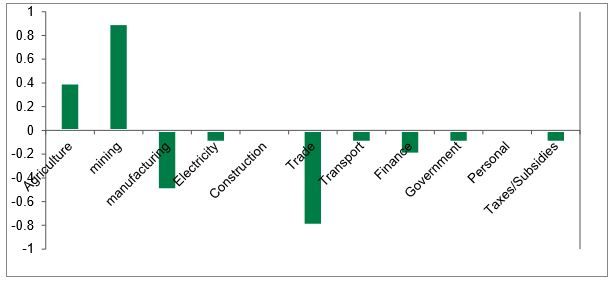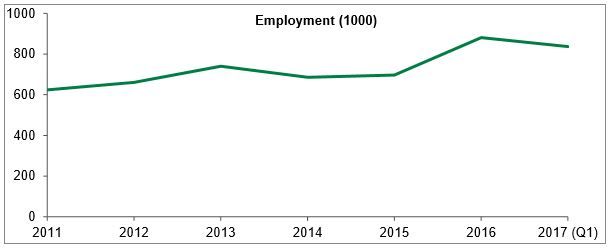South Africa's real gross domestic product (GDP) shrunk by 0,7% in the first quarter of 2017, following a decrease of 0,3% in the fourth quarter of 2016, Statistics South Africa (Stats SA) reported recently.
If an economy shrinks for two straight quarters (a total of six months), that indicates that economy has fallen into technical recession. This is what is reflected in Chart 1 below as far the South African economy is concerned.

Chart 1: Growth in GDP (%) - Data Source: Stats SA
Infringing on economic growth in South Africa are factors such as unstable political environment, sizeable contingent liabilities, deteriorating governance, corruption, lack of leadership and inadequate education, amongst others. If growth slips further down into the negative territory in the next quarter that will then indicate a full recession which could lead to further increase in unemployment as business activities, particularly on the primary production side, might become stunted. Furthermore, this could potentially see South Africa losing its status as the largest economy in Africa again.
For ordinary citizens, a recession can presents hardships in terms of an increase in prices. It does not bode well for the government either because tough economic times lead to over-reliance on the fiscus. To curb this, governments would react by increasing taxes - which the South African government has already proposed in the form of wealth tax - which ultimately adds more burden on ordinary citizens and limits productivity and profitability of sectors that are dependent on land as their major production factor like agriculture.
Agriculture shows resilience and remains the backbone of the economy
Chart 2 below, shows that mining and agriculture were the only two sectors that landed positive growth, contributing positively to the country’s GDP in the first quarter of 2017. Mining contributed 0.9% to the GDP. The agricultural (including forestry and fisheries) economy grew by 22% and contributed 0,4% to the country’s GDP. In contrast, trade and manufacturing were the largest negative contributors to the GDP—contributing -0.8% and -0.5% respectively.

Chart 2: Contributions to growth in GDP, Q1 2017 (% points) - Data Source: Stats SA
Even after the worst drought since 1992, the agricultural sector has shown strong signs of recovery and it continues to play a significant role in South Africa’s economy. Recently, Stats SA released the latest Quarterly Labour Force Survey results for the first quarter of 2017. The survey results show that the unemployment rate in South Africa increased to 27.7 percent in the first quarter of 2017 from 26.5 percent in the previous period.
Although the agricultural sector shed 44,000 jobs in the period under review, it remains critical for the country’s labour market, particularly the rural labour market. In 2016, the sector employed almost 900,000 people. This may appear as a low percentage of the workforce in South Africa, but in absolute terms, the number of people that are employed by the sector is considerably high.
Chart 3 below shows that the number of people working in agriculture had in increased by 29% from 624,000 in 2011 to 881,000 in 2016.

Chart 3: Employment in the Agriculture sector (2011-2017(Q1) - Data Source: Stats SA
In terms of growth in the sector, significant contributions came from subsectors such as horticulture, summer grains, and oilseeds – largely attributed to good summer rainfall. 2017 summer grain and oilseeds production are expected to reach a record high - 18 million tonnes with the key contributors being maize and soybean, which are set to reach record levels of more than 15m tonnes and more than 1.2m tonnes, respectively. (Data Source DAFF)
The diagram below gives more details of individual enterprises contribution to the total summer grain and oilseeds production for the 2016/17 production season.
Horticulture remains an area of growth for the sector. Given the growing demand for horticulture products such fruits in the world’s markets, it is fundamentally important that, for strategic growth in the sector, new entrants be encouraged and incentivised to enter the horticulture market.
Agriculture must be a national priority
Government must make agriculture development a national priority. There needs to be clear development framework that will create a clear and feasible roadmap for the sector.
For sustainability purposes, young people have a huge role to play in the sector. It is important that the government also develops a strategy for the elevation of young people in agriculture and access to the value chain. The farming community in South Africa is aging, and although some young people are making it big in the sector, there is still a lot who wants to enter the sector but the current environment prevents them from doing so.

















































